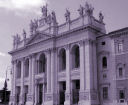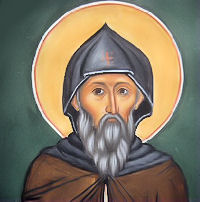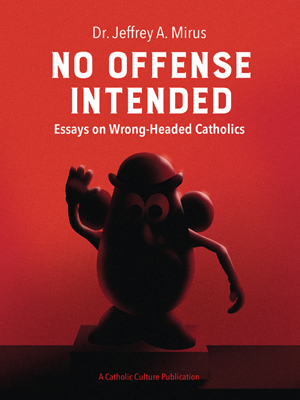Lent: March 30th
Thursday of the Fifth Week of Lent
Other Commemorations: St. John Climacus, Abbot (RM)
» Enjoy our Liturgical Seasons series of e-books!
The weekday Masses towards the end of Lent are like a Passion Play. The Gospels, as one scene after the other, show the mounting hatred and growing tension. This is the “Abraham Mass,” telling of the inheritance received through Abraham. The Opening Prayer reminds us of our great inheritance received from Christ.
The Roman Martyrology today honors St. John Climacus (born between 505 and 579 and died between 605 and 649), a learned abbot and great spiritual director. He was a monk of Mount Sinai and wrote The Ladder to Paradise which described the thirty degrees to religious perfection.
Meditation—The Custom of Meditating on Our Lord’s Passion
My people! What have I done, in what way have I offended you? Answer me. I gave you the water of salvation which flowed from my sorrow to drink and you gave me honey and vinegar. My people, what have I done to you? (Liturgy, Good Friday).
The liturgy of these days during Lent brings us closer to the fundamental mystery of our Faith—the Resurrection of the Lord. If the liturgical year is centered upon Easter then this period demands an even greater devotion on our part, given its proximity to the sublime mysteries of divine mercy (St. Leo the Great, Sermon 47). But we should not tread this path too hastily, lest we lose sight of a very simple fact which we might easily overlook. We will not be able to share in Our Lord’s Resurrection unless we unite ourselves with him in his Passion and death (cf. Rom 8:17). If we are to accompany Christ in his glory at the end of Holy Week, we must first enter into his holocaust and be truly united to him as he lies dead on Calvary (St. Josemaria Escriva, Christ is Passing By, 95). So during these days let us accompany Jesus, in our prayers, along his painful way to Calvary and his death on the cross. As we keep him company let us not forget that we too were protagonists in all those horrors, for Jesus bore the burden of our sins (cf 1 Pet 2:24), each and every one of them. We were freed from the hands of the devil and from eternal death at a great price (cf 1 Cor 6:20), that of the Blood of Christ.
The custom of meditating on the Passion began in the very earliest days of Christianity. Many of the faithful in Jerusalem had themselves been present as Christ passed through the streets of the city on the eve of the Pasch. They would never forget Jesus’ sufferings as he made his way to Calvary. The Evangelists dedicated a good part of their writings to the detailed account of those events. We should read our Lord’s Passion constantly, said St. John Chrysostom, what great benefit we will gain by doing so. Even if you are as hard as stone, when you contemplate that He was sarcastically adorned, then ridiculed, beaten and subjected to the final agonies, you will be moved to cast all pride form your soul. How many people have been converted by careful meditation on the Passion!
St. Thomas Aquinas said that the Passion of Christ is enough to serve as a guide and model throughout our lives (St. Thomas, About the Creed). One day while he was visiting St. Bonaventure, St Thomas asked him where he had acquired such good doctrine as the one that he set out in his works. It is said that St. Bonaventure showed him a crucifix, which was blackened from all the kisses he had given it, and explained This is the book that tells me what I should write; the little I know I have learned from it (St. Alphonsus Liguouri, Meditations on Christ’s Passion). From the crucifix the saints learned how to suffer and truly love Christ. We too should learn from it. Your crucifix…As a Christian, you should always carry your crucifix with you. And place it on your desk. And kiss it before going to bed and when you wake up; and when your poor body rebels against your soul, kiss it again (St. Josemaria Escriva, The Way, 302).
Our Lord’s Passion should be a frequent theme in our prayer, but especially so in these days leading up to the central mystery of our redemption.
—Francis Fernandez, In Conversation with God
St. John Climacus
Saint John, whose national origin remains unknown, was called Climacus because of a treatise he wrote called The Ladder (Climax) of Paradise. He made such progress in learning as a disciple of Saint Gregory Nazianzen that while still young, he was called the Scholastic. At the age of sixteen he turned from the brilliant future which lay before him, and retired to Mount Sinai, where he was placed under the direction of a holy monk named Martyrius. Once that religious journeyed to Antioch and took the young John with him; they visited Saint Anastasius, a future Patriarch of Antioch, and the Saint asked Martyrius who it was who had given the habit to this novice? Hearing that it was Martyrius himself, he replied, “And who would have said that you gave the habit to an Abbot of Mount Sinai?” Another religious, a solitary, made the same prediction on a similar visit, and washed the feet of the one who would some day be Abbot of Mount Sinai.
Never was there a novice more fervent, more unrelenting in his efforts for self-mastery. On the death of his director, when John was about thirty-five years old, he withdrew into a deeper solitude, where he studied the lives and writings of the Saints and was raised to an unusual height of contemplation. There he remained for forty years, making, however, a visit to the solitaries of Egypt for his instruction and inspiration. The fame of his holiness and practical wisdom drew crowds around him for advice and consolation.
In the year 600, when he had reached the age of seventy-five, he was chosen as Abbot of Mount Sinai by a unanimous vote of the Sinai religious, who said they had placed the light upon its lampstand. On the day of his installation, six hundred pilgrims came to Saint Catherine’s Monastery, and he performed all the offices of an excellent hotel-master; but at the hour of dinner, he could not be found to share the meal with them. For four years, said his biographer, a monk of the monastery of Raithe, “he dwelt on the mountain of God, and drew from the splendid treasure of his heart priceless riches of doctrine which he poured forth with wondrous abundance and benediction.” He was induced by a brother abbot to write the rules by which he had guided his life; and the book which he had already begun, The Ladder, detailing thirty degrees of advancement in the pursuit of perfection, has been prized in all ages for its wisdom, clearness, and unction.
At the end of that time, he retired again to his solitude, where he died the following year, as he had foretold.
—Excerpted from Les Petits Bollandistes: Vies des Saints, by Msgr. Paul Guérin (Bloud et Barral: Paris, 1882), Vol. 4.
Symbols and Representation: abbot carrying a ladder; man having a vision of a ladder being scaled by monks; monk on a ladder; clothed as a monk, sometimes with an Abbot's paterissa (crozier), sometimes holding a copy of his Ladder
Highlights and Things to Do:
- Read more about St. John Climacus:
- Watch this YouTube video on St. John Climacus.
- Pope Benedict XVI devoted his February 11, 2009, General Audience Address to St. John Climacus.
- You can download a pdf of The Ladder of Divine Ascent by John Climacus.
- St. John Climacus is honored also in the Eastern Catholic Churches (Eastern Rite) and Eastern Orthodox Church.

Holy Saturday--Easter Vigil of the Sacred Triduum
Station with San Giovanni in Laterano (St. John Lateran):
The Station returns again to St. John Lateran. During the afternoon of Holy Saturday the faithful were summoned here for the final scrutiny of the catechumens. Then, in the evening began the vigil or night of watching which concluded at dawn with the solemn baptisms—-the neophytes, plunged into the baptismal waters and there buried with Christ, were born to the life of grace at the very time when our Savior came forth triumphant from the tomb at dawn on Easter morning.
For more on San Giovanni in Laterano, see:
For further information on the Station Churches, see The Stational Church.








